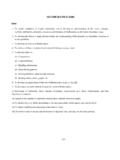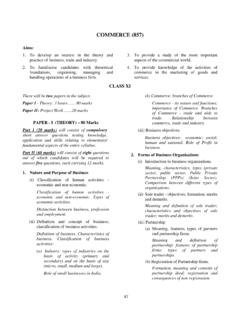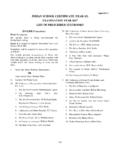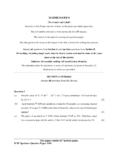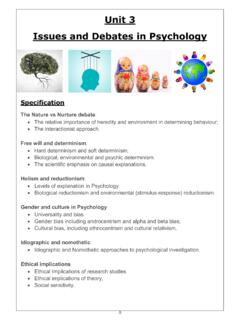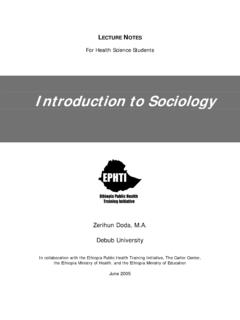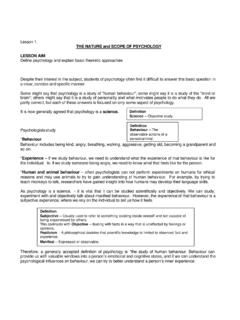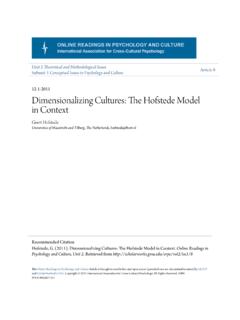Transcription of PSYCHOLOGY - CISCE
1 73 PSYCHOLOGY (855) Aims: (i) To develop an understanding of human behaviour: the nature of individuals and of members of social groups. (ii) To develop an understanding of the methods of research and study employed in PSYCHOLOGY . (iii) To develop an appreciation of the practical value of PSYCHOLOGY and its applications in daily XI There will be two papers in the subject: Paper I - Theory: 3 hours ..70 marks Paper II- Practical Work: ..30 marks PAPER - I (THEORY) 70 Marks Part I (20 marks) will consist of compulsory short answer questions relating to the fundamental aspects of the entire syllabus.
2 Part II (50 marks) will consist of two sections, A and B. Candidates will be required to answer two out of three questions from Section A and three out of five questions from Section B. Each question in this part shall carry 10 marks. SECTION A 1. The Subject PSYCHOLOGY (i) definition of PSYCHOLOGY ; Nature bio science, social science or pure science; schools of thought Structuralism, Functionalism, Behaviourism, Psychoanalysis, Gestalt PSYCHOLOGY . definition of PSYCHOLOGY , meaning of the terms behaviour, stimulus and response. Subject matter / nature of PSYCHOLOGY as a bio science, social science or pure science.
3 The eclectic approach of modern PSYCHOLOGY . Main features of the schools of Structuralism, Functionalism and Behaviourism, Psychoanalysis, Gestalt PSYCHOLOGY (two Psychologists of each approach and their relevant concepts). (ii) Fields of PSYCHOLOGY clinical, counselling, developmental, educational, organizational and social. The general importance and aims of studying PSYCHOLOGY and its special benefits. Applications - different branches and the kind of work done in special fields - clinical, counselling, developmental, educational, organizational and social (in brief).
4 (iii) Heredity and Environment meaning of the term heredity ; basic principles and mechanism of heredity (genetic). Meaning of the term environment ; importance of both heredity and environment in behaviour. The definition and role of chromosomes and genes (dominant and recessive); the laws of heredity: uniformity and variability. Significance of environment: physical and social. Heredity related diseases: Mental Retardation and Huntington s disease. How both heredity and environment interact to produce behaviour (Twin studies, Adoption Studies, Separated Twin Study). 2.
5 Methods of PSYCHOLOGY (i) Scientific Methods in PSYCHOLOGY -observation, case study, surveys, psychological tests, experimentation steps. Psychological tests and their uses. The application of scientific methods in the study of behaviour. What is meant by scientific observation? Field study; controlled and uncontrolled observation; longitudinal and cross-sectional studies; the case history method; the experimental method - variables and controls - steps in an experiment; surveys and use of questionnaires/self reports.
6 One advantage and one disadvantage for each method of PSYCHOLOGY . Meaning of samples (random, biased, representative); meaning of population. Psychological tests characteristics, definition , uses and types. (ii) Interpretation of research results use of statistics in interpretation of data -understanding of why statistics is used 74 (descriptive & inferential). Basic statistical concepts statistics, sample, population. Why statistics is used in PSYCHOLOGY - interpretation of findings: describing and summarizing data, comparing individuals/ groups, investigating relationships between variables, predicting.
7 Descriptive statistics - for summarizing scores. Inferential statistics - to determine whether observed differences between groups are likely/unlikely to have occurred by chance. How scores are grouped into frequency distributions; central tendency of a frequency distribution - mean, median, mode and when each measure is used; dispersion: the extent to which scores are spread out - range, variance, standard deviation; why both central tendency and variability are important in PSYCHOLOGY . 3. Attention and Perception (i) Nature of attention - its inner and outer determinants.
8 The importance of attention in perception - how both physical factors such as size, colour, movement, change, intensity, contrast and psychological factors such as need, interest and emotion determine attention and perception. (ii) Perceptual processes - difference between sensation and perception. Organizational principles of perception - laws, constancies, depth and colour perception. Process involved in transforming sensation to perception. Important factors in perceptual process - figure and ground, laws of grouping: similarity, proximity, continuation, simplicity, good figure; constancy of size, shape and colour; factors involved in depth perception -monocular and binocular cues; how colour is perceived - biological and psychological factors ; attributes of colour - hue, wavelength, brightness and saturation; laws of colour mixture; colour blindness, adaptation and after-images.
9 (iii) Errors in perception - illusions of size and shape; what is meant by extra-sensory perception (ESP). False interpretations - illusions: Muller-Lyer, Height -Width, Ponzo, Zoellner, Poggendorf (details of experiments are required); ESP - perceptions not based on any of the known senses (general understanding of ESP). SECTION B 4. Emotions and Motivation (i) What is meant by emotion; the basic emotions. Subjective and cognitive experience, physiological basis of emotion, reactions and overt expression. Primary emotions - fear, anger, joy, sorrow, affection.
10 (ii) Theories of emotion dealing with physiological, subjective and cognitive aspects. James Lange, Cannon Bard, Schachter - Singer theories. (iii) What is meant by motives, needs and instincts. Motivation as an internal force generating certain behaviour - biological needs and homeostasis; instincts as unlearned and physiological desires; evidence indicating the existence of unconscious motives. Intrinsic - the desire to perform activities for their own sake. (iv) Theories of Motivation. Pull and push theories, Optimum Arousal theory and Expectancy theory - Graphic representation of Maslow's Needs Hierarchy.
